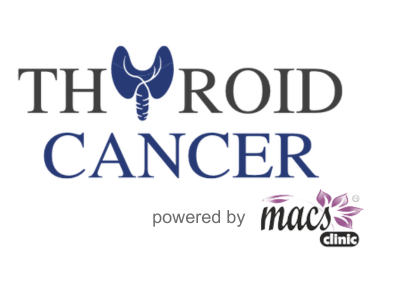Overview of Thyroid Cancer
This page discusses thyroid cancer, where we cover its different types and the signs to look out for. Check out our detailed pages for deeper dives into specific cancers and their treatments. We have created this overview of thyroid cancer with the support of MACS Clinic and Dr. Sandeep Nayak. Dr. Nayak is an experienced thyroid surgeon operating out of top-tier hospitals in Bangalore, India. He is known for pioneering the RABIT technique of robotic thyroidectomy. Please consult a thyroid specialist to discuss the thyroid cancer medical procedure.
You can explore the world of thyroid cancer on our website. And remember, we’re always adding fresh insights to keep you informed about thyroid health.
Understanding the Thyroid Gland
The thyroid gland resides in the front part of the neck. It resides below the thyroid cartilage, commonly known as Adam’s apple. The shape of the thyroid gland is similar to that of a butterfly. In most people, the thyroid cannot be seen or felt.
The thyroid gland performs several vital functions in the body, including regulation of:
- Metabolism
- Heart rate and blood pressure
- Body temperature
- Growth and development
- Energy levels
- Mood and cognitive function
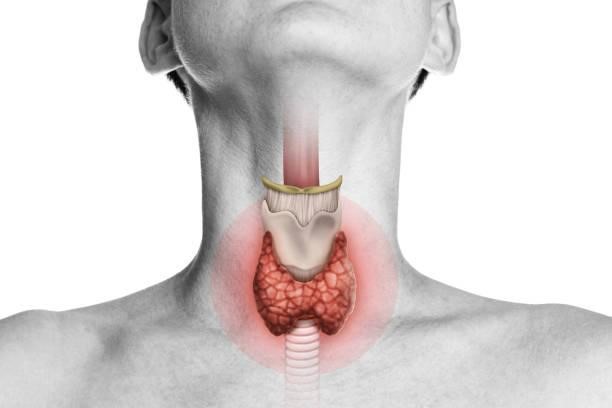
Now that you know about the thyroid gland and its role in the body, let’s delve into the specifics of thyroid cancer.
What Is Thyroid Cancer?
Thyroid cancer begins when cells in the thyroid gland grow uncontrollably. Different cancers develop from each kind of cell. The differences are significant because they affect how serious the cancer is and what treatment is needed.
The thyroid gland has different types of cells, the two main cell types being:
Follicular Cells
Follicular cells create thyroid hormones using iodine from the blood. They keep your body’s metabolism in check.
C cells
C cells, also known as parafollicular cells, make calcitonin to help manage calcium in the body.
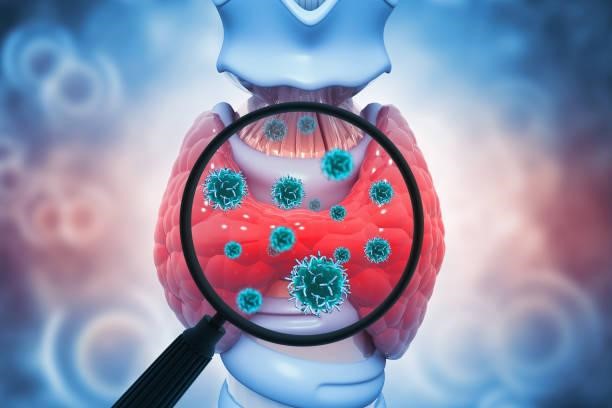
There are also other cells, like the immune system cells and supportive cells. They help keep the thyroid running smoothly.
The thyroid gland can develop various types of growths and tumors. Most of these are harmless (non-cancerous). However, some can be cancerous (malignant), spreading to nearby tissues and other body parts.
Each type of thyroid cancer has its unique traits. You can explore them further on our dedicated pages.
Symptoms Of Thyroid Cancer
Main sign or symptom of thyroid cancer is:
A noticeable painless lump or swelling in front of the neck.
Rest of the symptoms occur onlya when the cancer has advanced locally. Here are a few common signs to watch out for:
Changes in voice quality or persistent hoarseness.
Trouble swallowing or a sensation of a lump in the throat.
A chronic cough that doesn’t resolve with treatment.
Pain or pressure in the neck area, sometimes radiating to the ears.
Changes in the appearance of the neck, such as asymmetry or protrusion.
Enlarged or swollen lymph nodes in the neck, especially on one side.

Early detection is crucial, leading to timely intervention and improved outcomes.
Now, let’s explore the different types of thyroid gland cancer.
Have a Question?
Classification System Of Thyroid Cancer
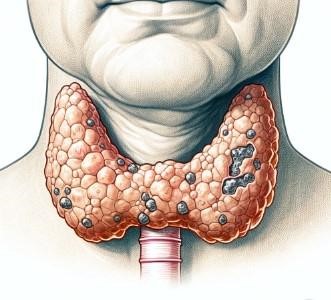
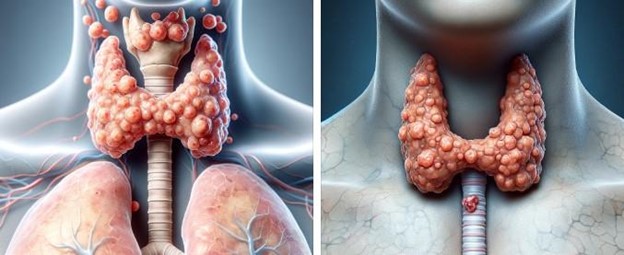
Here are the main types of thyroid cancer:
- Differentiated thyroid cancer (including papillary, follicular, and Hürthle cell)
- Medullary
- Anaplastic (a very aggressive type)
Most thyroid cancers fall under the category of differentiated cancers. These cancers develop from thyroid follicular cells. Their cells closely resemble normal thyroid tissue when examined in the lab.
Let’s get an understanding of these common thyroid cancers.
Papillary cancer
Papillary cancer is the most common type of thyroid cancer, accounting for about 8 out of 10 cases. They grow slowly, but despite that, they often spread to the lymph nodes in the neck. However, even when this happens, they can usually be successfully treated and are rarely fatal.
There are different subtypes of papillary cancers. You can read about them in our dedicated pages.
Follicular cancer
Follicular cancer, comprising about 1 out of 10 thyroid cancers, is the next most common type. It tends to occur more in areas or countries lacking iodine in the diet. Studies show the incidence of follicular and papillary thyroid cancer is higher in women.
Hürthle cell cancer
Hürthle cell cancer is also known as oxyphilic cell carcinoma or Hurthle cell carcinoma. It makes up about 3% of thyroid cancers. A rare type of thyroid cancer, it begins in the follicular cells of the thyroid gland. Hürthle cell cancer tends to grow more slowly than other types of thyroid cancer but may be more aggressive and harder to treat.
Medullary thyroid cancer
Medullary thyroid cancer (MTC) makes up about 4% of thyroid cancers. It starts from the C cells of the thyroid gland. Sometimes, MTC can spread to lymph nodes, lungs, or liver before you notice or find a thyroid nodule. This cancer type is challenging to detect and treat. There are two types, and you can read more about them on our dedicated pages.
- Sporadic Medullary thyroid cancer makes up 80% of cases. It is not inherited and often affects one thyroid lobe in older adults.
- Familial Medullary thyroid cancer is inherited. It affects 20-25% of each family generation. It often appears in childhood or early adulthood and spreads quickly to multiple areas in both lobes. MTC is known to increase the risk of other tumors.
Anaplastic thyroid cancer
Anaplastic thyroid cancer is also known as Anaplastic carcinoma or undifferentiated carcinoma. Though rare (it accounts for 2%-3% of all cancers of the thyroid), it is an aggressive form of thyroid cancer. It develops from follicular cells in the thyroid gland and proliferates. Due to its aggressive nature, anaplastic thyroid cancer is challenging to treat and has a poor prognosis.
Less common thyroid cancers
Less common thyroid cancers comprise less than 4% of all thyroid cancers. They include thyroid lymphomas, sarcomas, and other rare tumors.
Parathyroid cancer
Parathyroid cancer, although very rare, affects the small glands located behind the thyroid. These four tiny glands (Parathyroids) help regulate calcium levels in the body.
Sometimes, larger parathyroid cancers may present as nodules near the thyroid. Surgical removal is the primary treatment. Parathyroid cancer is more challenging to cure compared to other types of thyroid cancer.
Do you have or think you are at risk of developing thyroid cancer?
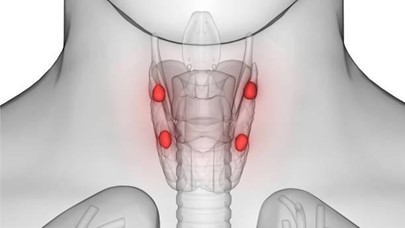
Overview of thyroid cancer treatment
Treating thyroid cancer commonly involves surgery as the primary approach. Total thyroidectomy entails removing the entire thyroid gland and serves as the cornerstone of treatment. At MACS Clinic, robotic surgery has emerged as the preferred method for thyroid surgery. Dr. Sandeep Nayak, the chief surgical oncologist at the clinic, and his skilled team offer minimally invasive procedures to combat thyroid cancer using RABIT technique of robotic thyroid surgery.
It’s crucial to entrust thyroid surgery to a specialized team experienced in performing these procedures. This not only reduces the risk of complications but also enhances treatment outcomes. They help promote optimal recovery and long-term management of thyroid cancer.
Explore Further:
Papillary Thyroid Cancer: The most prevalent type, known for its favorable prognosis.
Follicular Thyroid Cancer: Following closely, it boasts excellent treatment outcomes.
Hurthle Cell Thyroid Cancer: Less frequent, yet yields promising results when managed effectively.
Medullary Thyroid Cancer: A rare, occasionally hereditary variant demanding specialized attention.
Anaplastic Thyroid Cancer: A highly aggressive cancer in nature, though rare in occurrence.
How to Reach Us!
Each year, our center welcomes many patients from all corners of the globe. With our extensive experience, we have streamlined the process to make it effortless for you to visit Bangalore for your evaluation, scans, biopsies, and surgery all in one trip. For your convenience, a significant portion of the follow-up can be conducted through online consultations. Additionally, we are committed to assisting you with postoperative treatment in your home country or city, eliminating the need for you to return to Bangalore, India.
Curious about thyroid cancer? Find answers to common questions in our FAQ section!
Frequently Asked Questions
What are the risk factors for thyroid cancer?
Risk factors include:
- For most patients the cause is unknown.
- exposure to radiation
- family history of thyroid cancer
- certain genetic conditions
How is thyroid cancer diagnosed?
Diagnosis typically involves what is called quadruple assessment:
- physical examination
- imaging tests like ultrasound
- FNAC
- tests to measure thyroid hormone levels
What are the treatment options for thyroid cancer?
Treatment may include:
- surgery to remove the thyroid gland (thyroidectomy)
- radioactive iodine therapy
- hormone therapy
What are the potential complications of thyroid cancer treatment?
Complications may include:
- hypoparathyroidism leading to low calcium in blood.
- vocal cord paralysis
Can thyroid cancer recur after treatment?
Yes, thyroid cancer can recur even after successful treatment. Regular follow-up exams and monitoring are essential.
